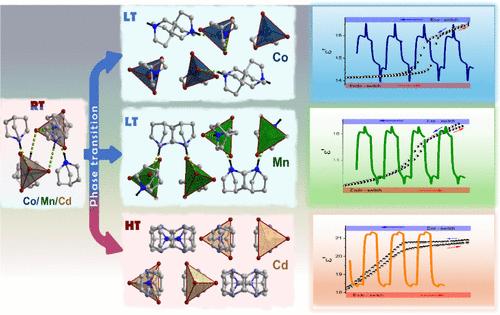有机-无机杂化喹啉基金属溴化物的结构多样性和稳定性
IF 4.7
2区 化学
Q1 CHEMISTRY, INORGANIC & NUCLEAR
引用次数: 0
摘要
我们合成了基于quinuclidinium 和金属溴化物 (C7H14N)2MBr4 (M = Co、Mn、Cd)的有机-无机杂化化合物。差示扫描量热法测量结果表明,所有化合物在加热到 251 K(钴)、205 K(锰)和 363 K(镉)时都会发生可逆相变。介电常数的温度相关性显示出异常,证实了相变的发生。虽然 X 射线衍射数据证实了晶体在室温下是等结构的,但每种化合物的相变机制各不相同。主要驱动力是奎宁环的重新定向,导致氢键的重新排列。这些材料具有令人满意的介电和热稳定性能,突出了它们在温度传感器和开关设备中的应用潜力。本文章由计算机程序翻译,如有差异,请以英文原文为准。

Structural Diversity and Stability of Organic–Inorganic Hybrid Quinuclidine-Based Metal Bromides
Organic–inorganic hybrid compounds based on quinuclidinium and metal bromides, (C7H14N)2MBr4 (M = Co, Mn, Cd), have been synthesized. Differential scanning calorimetry measurements indicate that all compounds undergo a reversible phase transition at 251 K (Co), 205 K (Mn), and 363 K (Cd) upon heating. The respective temperature dependences of the dielectric permittivity reveal anomalies, confirming the occurrence of phase transitions. Although the crystals are isostructural at room temperature, as confirmed by X-ray diffraction data, the mechanism of the phase transitions varies in each compound. The main driving force is the reorientation of quinuclidinium, resulting in the rearrangement of hydrogen bonds. Satisfactory dielectric and thermal stability properties of these materials have been demonstrated, highlighting their potential for applications in temperature sensors and switch devices.
求助全文
通过发布文献求助,成功后即可免费获取论文全文。
去求助
来源期刊

Inorganic Chemistry
化学-无机化学与核化学
CiteScore
7.60
自引率
13.00%
发文量
1960
审稿时长
1.9 months
期刊介绍:
Inorganic Chemistry publishes fundamental studies in all phases of inorganic chemistry. Coverage includes experimental and theoretical reports on quantitative studies of structure and thermodynamics, kinetics, mechanisms of inorganic reactions, bioinorganic chemistry, and relevant aspects of organometallic chemistry, solid-state phenomena, and chemical bonding theory. Emphasis is placed on the synthesis, structure, thermodynamics, reactivity, spectroscopy, and bonding properties of significant new and known compounds.
 求助内容:
求助内容: 应助结果提醒方式:
应助结果提醒方式:


